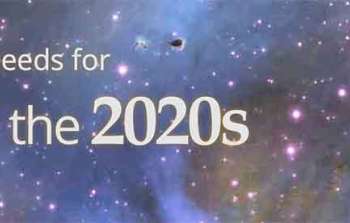sci19045 — Announcement
NOAO Community Survey for Astro2020: Overview of Survey Results
September 18, 2019
To help us prepare for the Astro2020 Decadal Survey, NOAO carried out a survey of community needs and resource priorities for the coming decade, inviting participation from all interested community members. Of the 476 people who responded to the online survey, carried out in May 2019, approximately one-third were students and postdocs, with the remainder split between faculty members with primarily research responsibilities and those with primarily teaching or service responsibilities.
Here we summarize the main messages that emerged from the survey. The quantitative survey results from which these are derived are available in the document linked at the end of this article.
The survey results affirm the continuing importance of ground-based OIR resources:
- Ground-based OIR resources will not only play important roles in all Astro2020 science areas, but they are also critical in accomplishing the community’s research goals for the coming decade.
- These resources will also continue to have strong scientific synergy with the use of space-based and other ground-based resources in the 2020s.
The survey also identified a clear need for diverse community resources and capabilities:
- Open access to facilities is important to the vast majority of the community, for apertures both large (ELTs, Gemini) and small (e.g., 0.9m).
- Users of externally-funded facilities, programs, and projects (e.g., DES on the Blanco, DESI on the Mayall, NN-EXPLORE on WIYN) are a significant (new) component of our research community. The publicly available data from these programs is also a valued community resource.
- NSF-funded community resources made available through NSF’s MSIP program are important to a significant fraction (more than half) of our community. Demand is high for future awards that would enable the use of diverse facilities (e.g., Magellan, Keck, MMT, VLT, Subaru, CHARA).
- Survey science remains in demand as a major pathway for discovery.
- Archival data, especially reduced data and data products, will be an important research resource in the 2020s.
- NSF’s OIR Lab should support software-related resources, especially general-purpose astronomy software (like IRAF or its replacement), as well as instrument- or project-specific pipelines, tools, and cookbooks, and science-quality reduced data products.
- Student and mentor training: high priority needs for student training include not only learning to observe at a telescope and basic data reduction and analysis, but also training in statistics and data science methods. Student mentors and established researchers also require training in accessing large data sets and in data science-related skills.
Perhaps most important for the Astro2020 Decadal Survey were the community’s overall resource priorities in a funding-limited environment. These fell into four priority tiers:
Tier 1 Observing time
Tier 2 Archival data products
New instruments
Software and data pipelines
Tier 3 Student training
New telescopes
Tier 4 Science platforms
Follow-up observing systems
Alert brokers
The overall priorities make a lot of sense. The resources in the first two tiers are familiar capabilities that are important to research now and in the coming decade. The resources in the fourth tier are new capabilities that are important to time domain science and large surveys; as new capabilities, they may have yet to attract a large community of users.
Notably, new telescopes, which fall in the third tier, are important but not the most critical need for the coming decade. The lower priority may result from their higher cost and/or longer development time. In this category, there is similar demand for ELTs and telescopes optimized for highly multiplexed spectroscopy.
One takeaway from the list of priorities is that if new telescopes are developed, their development should not compromise the higher priority needs for scientific success in the 2020s.
The quantitative survey results that underlie this summary are available here. The full text of the survey itself is available here. Questions, concerns, or comments about the survey may be directed to Joan Najita, MSO/CSDC Chief Scientist (najita@noao.edu).
Contacts
Joan Najita
Email: najita@noao.edu
MSO/CSDC Chief Scientist
About the Announcement
| Id: |
ID
sci19045
|
